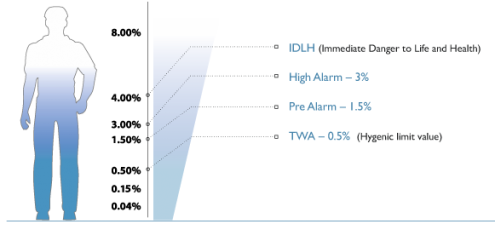 The Risks with CO2
The Risks with CO2
There is no reason why anyone should risk exposure to dangerous levels of CO2! For humans even a small increase of CO2 in the air is dangerous. Normal outdoor air has an average CO2 percentage of just 0.04%. At 1,5 % CO2 content humans reacts by increased heart rate and at 4 % CO2 there is an Immediate Danger to Life and Health (IDLH).
Watch our film about how to work safely with CO2
 As CO2 is used more and more in different applications, people are, in their daily life, both at work and free time, at risk of being exposed to CO2 levels that are above IDLH (Immediate Danger to Life and Health). For example, at gas (petrol) stations, convenience stores or fast food restaurants, where carbonated soft drinks are dispensed.
As CO2 is used more and more in different applications, people are, in their daily life, both at work and free time, at risk of being exposed to CO2 levels that are above IDLH (Immediate Danger to Life and Health). For example, at gas (petrol) stations, convenience stores or fast food restaurants, where carbonated soft drinks are dispensed.
To prevent accidents from happening, employers and staff, members need to know the risks associated from working with CO2 gas, be able to identify early symptoms, and be protected by a fixed or portable CO2 Safety Systems.
Based on the National Institute for Occupational Safety and Health (NIOSH) Pocket Guide to Chemical Hazards, common symptoms of CO2 exposure include dizziness, headache, poor sleep, lassitude, anxiety, ocular changes, coronary heart disease, gastritis, kidney and liver damage, eye and skin burns, and dermatitis. These symptoms will occur only if the NIOSH standard’s recommended exposure limit (REL) and / or Occupational Safety & Health Administration (OSHA) standard’s permissible exposure limit (PEL) exceed 5,000 ppm.
Calculate the CO2 level
The Carbon Dioxide concentration in a room depends on the VOLUME of the room and the amount of CO2 that is let into it. If there is a leak, the CO2 accumulates from the ground (because it is 1.5 times heavier than air). We have created a simple and easy tool to help assessing the risk of a CO2 leak.
Just fill in the floor area of the room in the calculator and the amount of the CO2 in Pounds or Kilos. We use 2.4 meters or 7feet 10 inches as a standard ceiling height. By doing this we calculate the volume. The potential CO2 concentration will be revealed by the calculator, helping you get a better understanding of the risk associated with the CO2 supply. For example, a 100-square foot basement with a small 20 pound CO2 tank is a lethal risk and the need for a proper CO2 safety system is a must!
Tutorial about CO2, it’s applications and US Safety Codes

 English
English Spanish
Spanish German
German French
French The Risks with CO2
The Risks with CO2